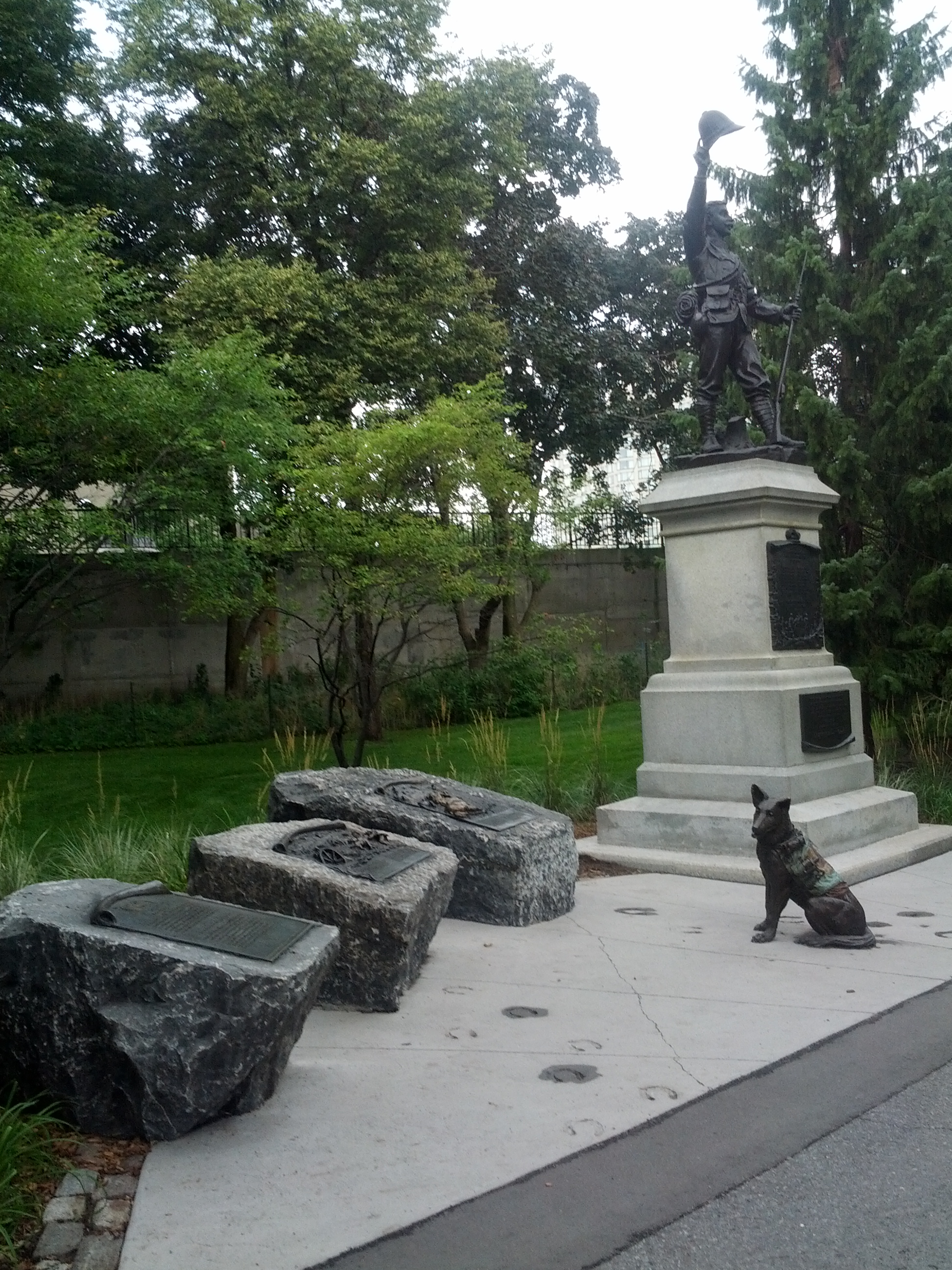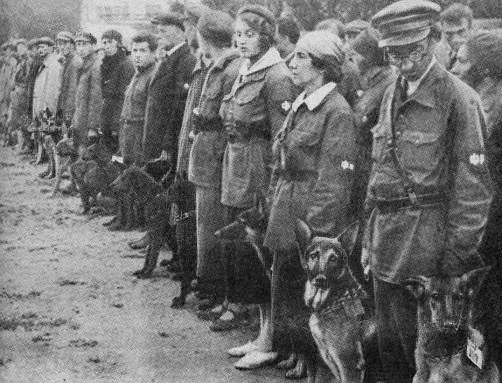|
Project Pigeon
During World War II, Project Pigeon (later Project Orcon, for "organic control") was American behaviorist B. F. Skinner's attempt to develop a pigeon-controlled guided bomb. Overview The testbed was the same National Bureau of Standards-developed, unpowered airframe that was later used for the US Navy's radar-guided "Bat" glide bomb, which was basically a small glider, with wings and tail surfaces, an explosive warhead section in the center, and a "guidance section" in the nose cone. The intent was to train pigeons to act as "pilots" for the device, using their cognitive abilities to recognize the target. The guidance system consisted of three lenses mounted in the nose of the vehicle, which projected an image of the target on a screen mounted in a small compartment inside the nose cone. This screen was mounted on pivots and fitted with sensors that measured any angular movement. One to three pigeons, trained by operant conditioning to recognize the target, were stationed ... [...More Info...] [...Related Items...] OR: [Wikipedia] [Google] [Baidu] |
Behaviorism
Behaviorism is a systematic approach to understanding the behavior of humans and animals. It assumes that behavior is either a reflex evoked by the pairing of certain antecedent (behavioral psychology), antecedent stimuli in the environment, or a consequence of that individual's history, including especially reinforcement (psychology), reinforcement and punishment (psychology), punishment three-term contingency, contingencies, together with the individual's current motivating operation, motivational state and Stimulus control, controlling stimuli. Although behaviorists generally accept the important role of heredity in determining behavior, they focus primarily on environmental events. Behaviorism emerged in the early 1900s as a reaction to depth psychology and other traditional forms of psychology, which often had difficulty making predictions that could be tested experimentally, but derived from earlier research in the late nineteenth century, such as when Edward Thorndike p ... [...More Info...] [...Related Items...] OR: [Wikipedia] [Google] [Baidu] |
Animal-borne Bomb Attacks
Animal-borne bomb attacks are the use of animals as delivery systems for explosives. The explosives are strapped to a pack animal such as a horse, mule or donkey. The pack animal may be set off in a crowd. Projects of bat bombs, dog bombs, and pigeon bombs, have also been studied. Incidents Afghanistan In 2009, Taliban insurgents strapped an improvised explosive device to a donkey and let the donkey loose a short way from a camp of the British Armed Forces in Helmand Province. Donkey ‘suicide’ bombing is latest tactic against patrols, Michael Evans, April 30, 2009, The Times of London. In April 2013, in Kabul, a bomb attached to a donkey blew up in front of a police security post, killing a policeman and wounding three civilians. A government spokesman claimed insurgents were challenging the competence of the Afghan government ... [...More Info...] [...Related Items...] OR: [Wikipedia] [Google] [Baidu] |
Psychology Experiments
Psychology is the scientific study of mind and behavior. Psychology includes the study of conscious and unconscious phenomena, including feelings and thoughts. It is an academic discipline of immense scope, crossing the boundaries between the natural and social sciences. Psychologists seek an understanding of the emergent properties of brains, linking the discipline to neuroscience. As social scientists, psychologists aim to understand the behavior of individuals and groups.Fernald LD (2008)''Psychology: Six perspectives'' (pp.12–15). Thousand Oaks, CA: Sage Publications.Hockenbury & Hockenbury. Psychology. Worth Publishers, 2010. Ψ (''psi''), the first letter of the Greek word ''psyche'' from which the term psychology is derived (see below), is commonly associated with the science. A professional practitioner or researcher involved in the discipline is called a psychologist. Some psychologists can also be classified as behavioral or cognitive scientists. Some psychol ... [...More Info...] [...Related Items...] OR: [Wikipedia] [Google] [Baidu] |
Military Animals Of World War II
A military, also known collectively as armed forces, is a heavily armed, highly organized force primarily intended for warfare. It is typically authorized and maintained by a sovereign state, with its members identifiable by their distinct military uniform. It may consist of one or more military branches such as an army, navy, air force, space force, marines, or coast guard. The main task of the military is usually defined as defence of the state and its interests against external armed threats. In broad usage, the terms ''armed forces'' and ''military'' are often treated as synonymous, although in technical usage a distinction is sometimes made in which a country's armed forces may include both its military and other paramilitary forces. There are various forms of irregular military forces, not belonging to a recognized state; though they share many attributes with regular military forces, they are less often referred to as simply ''military''. A nation's military may f ... [...More Info...] [...Related Items...] OR: [Wikipedia] [Google] [Baidu] |
World War II Weapons Of The United States
In its most general sense, the term "world" refers to the totality of entities, to the whole of reality or to everything that is. The nature of the world has been conceptualized differently in different fields. Some conceptions see the world as unique while others talk of a "plurality of worlds". Some treat the world as one simple object while others analyze the world as a complex made up of many parts. In '' scientific cosmology'' the world or universe is commonly defined as " e totality of all space and time; all that is, has been, and will be". '' Theories of modality'', on the other hand, talk of possible worlds as complete and consistent ways how things could have been. ''Phenomenology'', starting from the horizon of co-given objects present in the periphery of every experience, defines the world as the biggest horizon or the "horizon of all horizons". In ''philosophy of mind'', the world is commonly contrasted with the mind as that which is represented by the mind. ''T ... [...More Info...] [...Related Items...] OR: [Wikipedia] [Google] [Baidu] |
War Pigeon
Homing pigeons have long played an important role in war. Due to their homing ability, speed, and altitude, they were often used as military messengers. Carrier pigeons of the Racing Homer breed were used to carry messages in World War I and World War II, and 32 such pigeons were presented with the Dickin Medal. During World War I and World War II, carrier pigeons were used to transport messages back to their home coop behind the lines. When they landed, wires in the coop would sound a bell or buzzer and a soldier of the Signal Corps would know a message had arrived. The soldier would go to the coop, remove the message from the canister, and send it to its destination by telegraph, field phone, or personal messenger. A carrier pigeon's job was dangerous. Nearby enemy soldiers often tried to shoot down pigeons, knowing that released birds were carrying important messages. Some of these pigeons became quite famous among the infantrymen for whom they worked. One pigeon, named "Spi ... [...More Info...] [...Related Items...] OR: [Wikipedia] [Google] [Baidu] |
Pigeon Intelligence
Pigeons have featured in numerous experiments in comparative psychology, including experiments concerned with animal cognition, and as a result there is considerable knowledge of pigeon intelligence. Available data show, for example, that: *Pigeons have the capacity to share attention between different dimensions of a stimulus, but (like humans and other animals) their performance with multiple dimensions is worse than with a single stimulus dimension. *Pigeons can be taught relatively complex actions and response sequences, and can learn to make responses in different sequences. *Pigeons readily learn to respond in the presence of one simple stimulus and withhold responding in the presence of a different stimulus, or to make different responses in the presence of different stimuli. *Pigeons can discriminate between other individual pigeons, and can use the behaviour of another individual as a cue to tell them what response to make. *Pigeons readily learn to make discriminative res ... [...More Info...] [...Related Items...] OR: [Wikipedia] [Google] [Baidu] |
Military Animals
Military animals are trained animals that are used in warfare and other combat related activities. As working animals, different military animals serve different functions. Horses, elephants, camels, and other animals have been used for both transportation and mounted attack. Pigeons were used for communication and photographic espionage. Many other animals have been reportedly used in various specialized military functions, including rats and pigs. Dogs have long been employed in a wide variety of military purposes, more recently focusing on guarding and bomb detection, and along with dolphins and sea lions are in active use today. Use For transportation and hauling * The horse was the most widely used animal throughout the recorded history of warfare. Early mounts could pull a chariot or carry lightly armored skirmishing forces. With the appearance of heavier mounts and the invention of the stirrup, the horse-mounted cavalry became the most prestigious combat arm in E ... [...More Info...] [...Related Items...] OR: [Wikipedia] [Google] [Baidu] |
Ethology
Ethology is the scientific study of animal behaviour, usually with a focus on behaviour under natural conditions, and viewing behaviour as an evolutionarily adaptive trait. Behaviourism as a term also describes the scientific and objective study of animal behaviour, usually referring to measured responses to stimuli or to trained behavioural responses in a laboratory context, without a particular emphasis on evolutionary adaptivity. Throughout history, different naturalists have studied aspects of animal behaviour. Ethology has its scientific roots in the work of Charles Darwin and of American and German ornithologists of the late 19th and early 20th century, including Charles O. Whitman, Oskar Heinroth, and Wallace Craig. The modern discipline of ethology is generally considered to have begun during the 1930s with the work of Dutch biologist Nikolaas Tinbergen and Austrian biologists Konrad Lorenz and Karl von Frisch, the three recipients of the 1973 Nobel Prize in Phys ... [...More Info...] [...Related Items...] OR: [Wikipedia] [Google] [Baidu] |
Bat Bomb
Bat bombs were an experimental World War II weapon developed by the United States. The bomb consisted of a bomb-shaped casing with over a thousand compartments, each containing a hibernating Mexican free-tailed bat with a small, timed incendiary bomb attached. Dropped from a bomber at dawn, the casings would deploy a parachute in mid-flight and open to release the bats, which would then disperse and roost in eaves and attics in a . The incendiaries, which were set on timers, would then ignite and start fires in inaccessible places in the largely wood and paper constructions of the Japanese cities that were the weapon's intended target. The United States Navy took control in August 1943, using the code name ProjectX-Ray. Conception The bat bomb was conceived by Lytle S. Adams (1881-1970), a dental surgeon from Irwin, Pennsylvania who was an acquaintance of First Lady Eleanor Roosevelt. The inspiration for Adams' suggestion was a trip he took to Carlsbad Caverns National Park, wh ... [...More Info...] [...Related Items...] OR: [Wikipedia] [Google] [Baidu] |
Anti-tank Dog
Anti-tank dogs (russian: собаки-истребители танков ''sobaki-istrebiteli tankov'' or ''protivotankovye sobaki''; german: Panzerabwehrhunde or ''Hundeminen'', "dog-mines") were dogs taught to carry explosives to tanks, armored vehicles and other military targets. They were intensively trained by the Soviet Army, Soviet and Armed Forces of the Russian Federation, Russian military forces between 1930 and 1946, and used from 1941 to 1943, against German tanks in World War II. Initially dogs were trained to leave a timer-detonated bomb and retreat, but this routine was replaced by an impact-detonation procedure which killed the dog in the process. The United States Armed Forces, U.S. military started training anti-tank dogs in 1943 in the same way the Russians used them, but this training exposed several problems and the program was discontinued. Background In 1924, the Revolutionary Military Council of the Union of Soviet Socialist Republics approved the use o ... [...More Info...] [...Related Items...] OR: [Wikipedia] [Google] [Baidu] |
.jpg)







